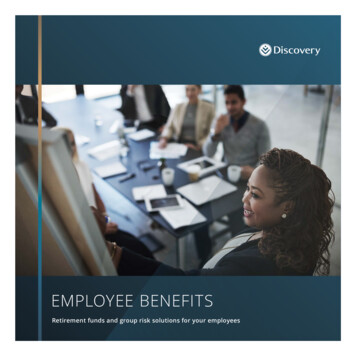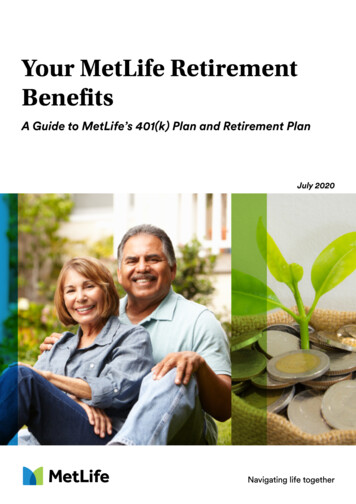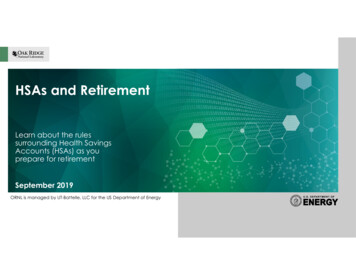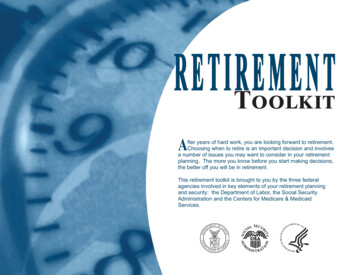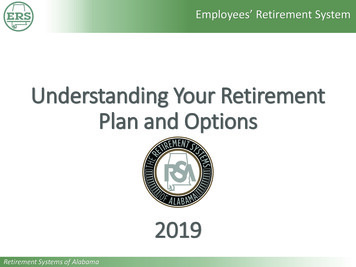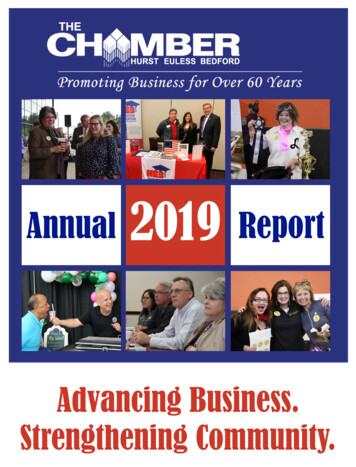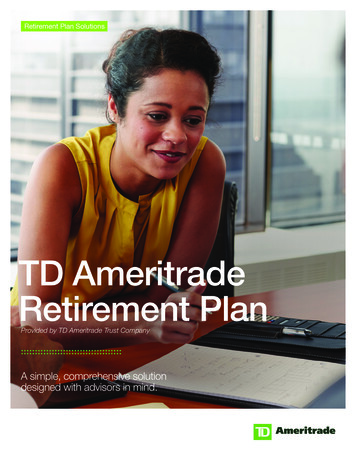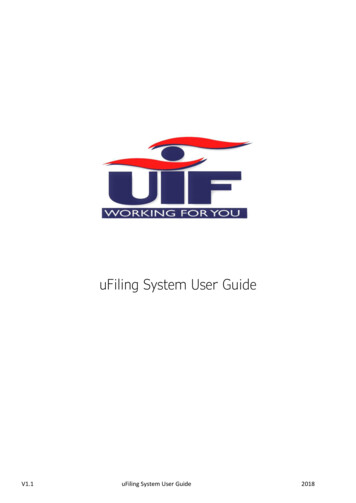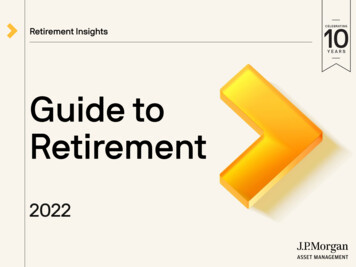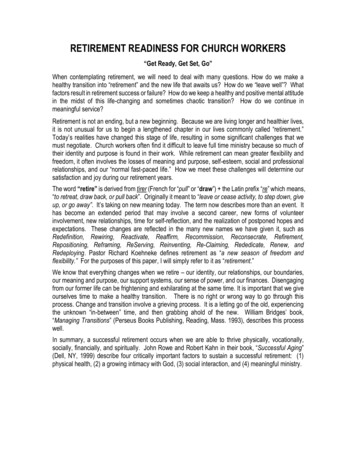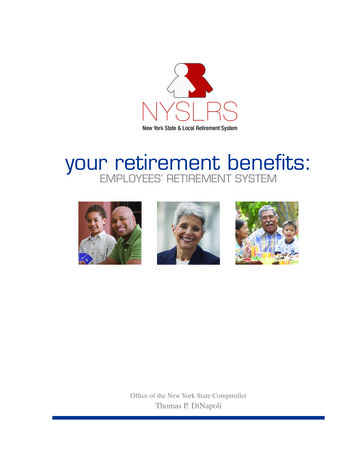
Transcription
Office of the New York State ComptrollerThomas P. DiNapoliNYSLRSNew York State & Local Retirement System110 State Street, Albany, New York 12244-0001your retirement benefits:EMPLOYEES’ RETIREMENT SYSTEMOffice of the New York State ComptrollerThomas P. DiNapoli
Office of the New York State ComptrollerThomas P. DiNapoliNYSLRSNew York State & Local Retirement System110 State Street, Albany, New York 12244-0001your retirement benefits:EMPLOYEES’ RETIREMENT SYSTEMOffice of the New York State ComptrollerThomas P. DiNapoliZO1835 (Rev. 1/21)1
table of contentsA Message from State Comptroller Thomas P. DiNapoli. 3Your NYSLRS M embership. 5Service Credit. 9Final Average Earnings. 15Retirement Plans. 21Preparing for Your Retirement. 29Applying for Your Service Retirement Benefit. 39After You Retire. 45Death Benefits. 51Survivor’s Benefit Program. 57Your Obligations. 59ZO1835 (Rev. 1/21)2
A MESSAGE FROM STATE COMPTROLLER THOMAS P. DINAPOLIDear NYSLRS Member:This book describes your New York State and Local Retirement System (NYSLRS) benefits. It willbe a valuable resource for you — especially as you approach retirement. We also offer other resourcesto help you understand your benefits so you can successfully plan for retirement.Use these resources to get details about your NYSLRS account and your benefits:n Sign up for Retirement Online. It’s a convenient and secure way to review your NYSLRSbenefits. You can use Retirement Online to update your contact information and beneficiaries,apply for a loan, apply for previous service credit, estimate your pension benefit, file forretirement and more. Register, sign in or learn more at web.osc.state.ny.us/retire/sign-in.php.n Review your Member Annual Statement, which provides your NYSLRS membership detailsto you every summer.n If you have any questions or you need more information, call toll-free 866-805-0990 or518-474-7736 in the Albany, New York area.Visit our website (www.osc.state.ny.us/retirement) for pre-retirement planning resources and to:n Read your retirement plan booklet and other NYSLRS publications that outline and explainyour benefits.n Subscribe to our blog, New York Retirement News, like us on Facebook and follow us on Twitterfor tools, quick tips and information on a variety of retirement topics.n Sign up for E-News, our monthly email newsletter, for the latest NYSLRS news.I am joined by a staff of dedicated professionals who are committed to helping you make informeddecisions about your future. I encourage you to contact us with any questions you have.Sincerely,Thomas P. DiNapoliState ComptrollerZO1835 (Rev. 1/21)3
This page intentionally left blank.ZO1835 (Rev. 1/21)4
YOUR NYSLRSmembership As a public servant in New York State and a member of one of the world’s largestpublic pension systems, you are covered by a retirement plan that provides importantbenefits. Whether you have just joined or have been a member your entire career, it isimportant to know about these benefits.NYSLRS is a defined-benefit plan. Your retirement benefit will be based on factorssuch as your tier, retirement plan, service credit, final average earnings (FAE) and ageat retirement.This publication explains your rights and obligations as a member. It clarifies thefactors that affect your retirement benefits and provides you with examples of howthose benefits are determined. It also takes you step-by-step through the retirementprocess and provides information about a variety of post-retirement matters.ZO1835 (Rev. 1/21)5
Stay InformedYour retirement benefits are an important partof a solid financial plan. They can help you andyour beneficiaries achieve financial security inretirement or in the event of disability or death.Use these tips to help you stay informed aboutyour benefits.n Manage your NYSLRS account usingRetirement Online at web.osc.state.ny.us/retire/sign-in.php.n Review your Member Annual Statementand notify us of any errors.n Visit our website (www.osc.state.ny.us/retirement) to learn about your benefits,find forms (www.osc.state.ny.us/retirement/forms), read publications (www.osc.state.ny.us/retirement/publications),and get tips on preparing for retirement.n Attend a pre-retirement presentation tolearn about the retirement process anddiscuss post-retirement issues. At youremployer’s request, we offer these presentations designed for members withinfive years of retirement eligibility.n Schedule a pre-retirement consultationwith one of our information representatives to review your benefits and getanswers to your retirement re-retirement-consultations).n Keep your mailing address and emailaddress current by updating your contact information in Retirement Online(use a personal email address that youwill have before and after you retire,rather than a work email address). Thisis especially important if you leave public employment before you are eligibleto retire.n Subscribe to our blog, New York Retirement News (www.nyretirementnews.com), where you’ll find tools to helpyou understand your benefits, as wellas important retirement news.n Like us on Facebook (www.facebook.com/nyslrs) and follow us on Twitter(www.twitter.com/nyslrs) for quick tipsand updates on a variety of retirementtopics.n Sign up for E-News, our email news letter hp), for the latest NYSLRSnews and information dedicated to preretirement planning.n Read your member newsletter, TheUpdate etters), for currentretirement information and updates onyour benefits.Contact UsIf you have any questions or you need moreinformation, we’re glad to help. You’ll findanswers to most common questions at www.contactNYSLRS.com, but you can also:n Email: www.emailNYSLRS.com;n Call: 866-805-0990, or 518-474-7736in the Albany, New York area;n Fax: 518-473-5590; orn Write:NYSLRS110 State StreetAlbany, NY 12244-0001ZO1835 (Rev. 1/21)6
Retirement ConsultationsIf you’re nearing retirement, you may wantto speak with one of our information representatives to review your benefits and get answers toyour questions. Current details about this serviceappear on our Pre-Retirement Consultationswebpage at ent-consultations.You will need an appointment for a consultation. To schedule one, please call toll-free866-805-0990 or 518-474-7736 in the Albany,New York area.Preparing for Your Consultationn Before your consultation, you may wishto sign in to your Retirement Online account (web.osc.state.ny.us/retire/sign-in.php) to review the information we haveon file for you. You can check your totalservice credit and use the online benefitcalculator to estimate your pension.If you don’t have a Retirement Onlineaccount, you can sign up today.n Visit our Preparing for Retirement webpage retirement). Thistimeline walks you through importanttopics you’ll need to consider, and stepsyou should take starting 18 monthsbefore your retirement date.n Check our Contact Us webpage (www.contactNYSLRS.com) for answers to avariety of retirement-related questions.ZO1835 (Rev. 1/21)7
Your Membership TierTier ReinstatementMembers are categorized into different “tiers”based on their date of membership. There aresix tiers in the Employees’ Retirement System(ERS). Tier status determines the following:If you had a previous membership inNYSLRS or any of the following public retirement systems, your service may be recreditedand your date of membership and tier restored.However, an earlier tier of membership does notalways result in a better benefit. Please contactus regarding your previous membership and thepotential for reinstatement.n Contribution requirements;n Benefit eligibility;n Service crediting;n Formulas used to calculate your finalaverage earnings and retirement benefit;n New York State and LocalPolice and Fire Retirement Systemn Loan eligibility;n New York State Teachers’Retirement Systemn Vesting requirements; andn Death benefit coverage.You Are In:If You Joined:Tier 1Before July 1, 1973Tier 2July 1, 1973, through July 26, 1976Tier 3July 27, 1976, through August 31, 1983Tier 4September 1, 1983,through December 31, 2009Tier 5January 1, 2010, through March 31, 2012Tier 6April 1, 2012, or aftern New York City Employees’Retirement Systemn New York City Board ofEducation Retirement Systemn New York City Police Pension Fundn New York City Fire DepartmentPension Fundn New York City Teachers’Retirement SystemNOTE: There is no Tier 4 for New York State correction officers.If you joined July 27, 1976, through December 31, 2009, youare a Tier 3 member. Security hospital treatment assistants(SHTAs) under the jurisdiction of the Office of Mental Healthwho joined September 1, 1983, through December 31, 2009,and elected the Article 14-CO plan before January 1, 1990,or within one year of becoming employed in this title, are alsoTier 3 members. SHTAs who joined during this same periodand did not elect this plan are in Tier 4.ZO1835 (Rev. 1/21)8
service credit As a NYSLRS member, you earn service credit for your public employment while onthe payroll of a participating employer.Your service credit is a key factor in determining your eligibility for and/or thecalculation of retirement and death benefits, vested rights and member loans. Sinceyour benefits are directly related to your service credit, it is important to make sureyou have credit for all your allowable service.ZO1835 (Rev. 1/21)9
Service CreditingArticle 19 Service CreditYou earn service credit for public employmentwhile on the payroll of a participating employer.Your employer reports your days worked toNYSLRS.If you are an eligible Tier 1 or 2 member whosemembership date is prior to July 27, 1976, youwill receive an additional month of servicecredit for each year of credited service you haveat retirement, up to a maximum of 24 months.This additional service credit will be includedin your benefit calculation at retirement.The number of hours that constitute a standardworkday is established by your employer. For Tier2, 3, 4, 5 and 6 members, it is at least six hours perday, but not more than eight.A full year of service credit is given for fulltime service. Generally, 260 workdays per yearare equivalent to full-time credit, except formembers employed in an educational setting(see bulleted information below).Part-time employment, except as noted below,is credited as the lesser of: number of daysworked 260 days or annual earnings reported (State’s hourly minimum wage 2,000).n Institutional teachers may receive fullservice credit if they work at least 200days each year. (Institutional teachersare teachers who work in New YorkState run institutions such as developmental centers or prisons.)n Ten-month school district employees,and teachers employed by New YorkState schools for the deaf and blind,who work at least 180 days in theschool year receive credit for a full year.n College employees who work full-time(170 days per year) for the academicyear receive a full year of service credit.Regardless of your membership tier, creditis not given for leaves of absence without payor for any period of time you do not receiveearnings. There may be exceptions if you areon sick leave at half-pay or receiving workers’compensation benefits.To be eligible for an increased retirementbenefit under Article 19, you must have been inactive service continuously from April 1, 1999,through and including October 1, 2000. Activeservice means:n Being paid on the payroll;n On a leave of absence with pay;n On an authorized leave without pay; orn Any period of time between school termsand any time between September 1, 2000,and October 1, 2000, for teachers or otheremployees who work the school year.Those not eligible for the additional servicecredit provided by Article 19 include:n Members who retire under a special20-year plan that allows for serviceretirement without regard to age.n Members in employment certified asconsisting of 50 percent or more incriminal law enforcement, who retireunder a plan that allows for serviceretirement without regard to age andhave earned 25 years of creditableservice. However, Article 19 benefitsdo apply to correction officers.n Members of the New York State andLocal Police and Fire RetirementSystem (PFRS).You can check your estimated service creditusing Retirement Online (web.osc.state.ny.us/retire/sign-in.php).ZO1835 (Rev. 1/21)10
Unused, Unpaid Sick LeaveUnused, unpaid sick leave may be addedto your credited service and used in yourbenefit calculation if you are a New York Stateemployee or if your employer has chosen tooffer the optional sick leave benefit provided bySection 41(j) of Retirement and Social SecurityLaw (RSSL).To be eligible for this benefit, you must retiredirectly from public service or within a year ofseparating from service.The additional credit is determined by dividingyour total unused, unpaid sick leave days by 260.For many members, the maximum numberof sick leave days allowable is 165. For mostTier 6 members, it’s 100 days. However, forsome members employed by New York State,the maximum is 200 days. Check with youremployer to see if they offer this benefit.Credit for your unused sick leave at retirementcannot be used to:n Qualify for vesting. For example, if youhave four years and ten months of servicecredit and you need five years to be vested,your sick leave credit cannot be used toreach the five years.n Qualify for a better retirement benefitcalculation. For example, if you have19½ years of service credit but yourpension calculation will improvesubstantially if you have 20 years,your sick leave credit cannot be usedto reach the 20-year calculation.n Increase your pension beyond themaximum amount payable under yourretirement plan.n Meet the service credit requirement toretire under a special 20- or 25-year plan.ExampleFor a member whose full-time day is 8 hours# hours unused sick leavefull-time hours per day # days additionalservice credit13208 165 days additionalservice credit# days additional service creditadditional 260service credit165260 .63 of a year additionalservice creditZO1835 (Rev. 1/21)11
Credit for Additional or MilitaryServiceYou may be able to purchase credit towardyour retirement benefit for additional publicemployment or military service. There is usuallya cost to receive credit for additional service.Purchasing additional service credit is optional,but because service credit is a factor in calculating a NYSLRS pension benefit, purchasingservice credit will generally increase yourpension benefit.Examples of additional service include paidemployment with a participating employerbefore you joined NYSLRS, or employmentwith a public employer before that employerelected to participate in NYSLRS.You may also be able to receive credit for active military service. There are different sectionsof the law that allow credit for military service.The cost depends on which section of the lawapplies in your case, and in some circumstancesthere is no cost. For more information, visit ourMilitary Service Credit webpage at rvice-credit.You may want to claim all the service credityou are entitled to receive as early as possible,because:n If there is a cost, it is generally lessexpensive than if you wait to purchaseat a later date;n We can process your retirement benefitmore quickly if your service credit is inorder;n Records documenting your service willmore likely be available; andn If your tier or retirement plan allowsyou to stop making contributions aftera certain period of time, you will stoppaying contributions sooner.Please note that certain types of service creditmay not provide additional benefits, for example,if you are in a special plan that allows for retirement after 20 or 25 years of service (regardless ofage) in specific job titles. If you have questions,contact us (www.contactNYSLRS.com) to verifywhether your additional service can be used inthe calculation of your benefit.Applying for Previousor Military Service CreditTo request credit for additional or militaryservice, sign in to your Retirement Online account (web.osc.state.ny.us/retire/sign-in.php),scroll down to the ‘My Account Summary’area of your Account Homepage and click the“Manage my Service Credit Purchases” button.The Service Credit Purchase Accounts pagewill appear. Click “Request Additional ServiceCredit.”You can also apply by mail by submitting aRequest to Purchase Service Credit (includingany military service) (RS5042) available onour Forms webpage at www.osc.state.ny.us/retirement/forms.For all requests, you must apply before yourdate of retirement. Include all the details youcan about the period of employment for whichyou are seeking credit. We will determine youreligibility and inform you of any cost.For military service requests, attach/include acopy of your Certificate of Release or Dischargefrom Active Duty (DD-214). (It must show thatyou were honorably discharged.)To establish eligibility for a vested retirementbenefit, you must request your credit while onthe payroll of a participating employer. If youmake your request, but receive your statementof cost after you leave payroll, you have 30 daysto make your payment.ZO1835 (Rev. 1/21)12
Service From a Previous MembershipIf you previously were a member of NYSLRS,or another public retirement system in New YorkState, your service may be recredited and yourdate of membership and tier restored. However,an earlier tier of membership does not alwaysresult in a better benefit. Please review your options carefully before making your decision, andcontact us with any questions you may have.For reinstatement to an earlier membershipwithin NYSLRS, or for reinstatement to an earliermembership in another public retirement system, sign in to your Retirement Online account.From your Account Homepage, go to the ‘MyAccount Summary’ area and click “Reinstate aPrevious Membership.” You can also apply bymail by submitting the Application to Reinstatea Former Membership (RS5506).All Types of Additional Service CreditSome things to remember:n Even if you included past service on yourmembership application, you must requestadditional service to receive credit for it.n Make your request well before you expectto retire. This gives us sufficient time toget salary and service records from youremployer(s), and it allows you ampletime to pay for the credit, if necessary.n Generally Tier 2, 3, 4, 5 and 6 membersneed two years of service credit in theircurrent memberships before they canreceive credit for service.n Members may need at least five yearsof service credit in their current memberships before they can claim creditfor military service. It depends on theparticular statute governing the service.n To establish eligibility for a vestedretirement benefit, you must requestcredit for your previous service whileon the payroll of a participating employer. If you receive notice of anassociated cost after you’ve left payroll,you must pay the full amount within30 days or you will not receive creditfor the service.Mandatory ContributionsIf you are covered by a plan that requirescontributions (Tier 3, 4, 5 and 6 members),and if insufficient contributions were made toNYSLRS, you may owe mandatory paymentsassociated with your past service. In that case,we will notify your employer so you can beginmaking payments. Any mandatory contributions that have not been paid by your date ofretirement will cause a permanent reductionto your monthly benefit.ZO1835 (Rev. 1/21)13
Paying for AdditionalService CreditThere is usually a cost to receive credit foradditional service. We will provide you with aletter indicating the amount of service credit youare eligible to receive and any applicable cost.If you are seeking credit for military serviceor public employment before your membershipdate, any associated payments are optional.Your cost letter will provide payment optionsand a due date, after which your cost wouldhave to be recalculated. The cost accumulates5 percent interest compounded annually.To find out how purchasing additional servicewould affect your pension, use the benefit calculator in Retirement Online. The calculator usesyour salary and service credit information to create an estimate. You can fine-tune your estimateby entering different retirement dates, beneficiaries, earnings, and service credit amounts. Pleasecontact us (www.contactNYSLRS.com) with anyquestions you have.If there is a cost to secure credit for additionalservice, there are three ways you can makepayment:1. A single lump sum to cover the entirecost of the service;2. Payroll deductions (you may makeadditional payments if you want to payoff the balance sooner); or3. A trustee-to-trustee transfer from one ofthe allowable plans below.408(a) or 408(b) IndividualRetirement Account403(a) Annuity Plan403(b) Tax-Sheltered Annuity401(a) or 401(k) Qualified DefinedBenefit or Contribution Plan457 Governmental DeferredCompensation PlanTransfers from Roth IRAs, inherited IRAs orinherited Roth IRAs are not permitted.About Payroll Deductionsn The payment period cannot exceed theamount of service credit being purchased.For example, if you are purchasing threeyears of service credit, payroll deductionscan be made for up to three years, or untilyour date of retirement, whichever comesfirst.n At the time of retirement, the total costof any additional service must be paidin full or you will receive credit only forthat part of your previous service thatwas paid.ZO1835 (Rev. 1/21)14
final average earnings Your Final Average Earnings (FAE) is an important factor in the calculation of yourretirement benefit. For ERS members in Tiers 1 through 5, FAE means the average of thethree highest consecutive years of earnings in covered public employment. For Tier 6members, it is the average of the five highest consecutive years of earnings. This is usuallythe last years of employment immediately before retirement (the years do not need tomatch up with calendar years or fiscal years). However, if there is a consecutive three- orfive-year period of earnings earlier in your career that will result in a higher FAE, we willuse that higher FAE to calculate the benefit. We do the FAE comparison automatically atthe time of your retirement. The earnings used in the FAE calculation may be subject tocertain limitations on the date you joined NYSLRS.ZO1835 (Rev. 1/21)15
THREE-YEAR FINAL AVERAGE EARNINGSTiers 1, 2, 3, 4 and 5A three-year FAE is the average of the wagesearned during any three consecutive years ofservice when earnings were highest. This isusually the last three years of employment.The FAE calculation can include, but is notlimited to, the following types of paymentsearned during the FAE period:n Regular salary;ExampleDate of Retirement 3/9/2020Earnings PeriodUsable EarningsYear 1: 3/9/2019 – 3/8/2020 46,723Year 2: 3/9/2018 – 3/8/2019 44,912Year 3: 3/9/2017 – 3/8/2018 42,336 133,971 3 44,657 FAEn Holiday pay;n Longevity payments;n Overtime pay;* andn Vacation pay, up to 30 days for memberswho joined prior to April 1, 1972, orafter July 26, 1976, if the FAE is basedon the earnings three years immediatelypreceding retirement.In most cases, the following payments cannotbe included in the FAE:n Unused sick leave;n Payments made as a result of workingyour vacation;n Any form of termination pay;n Payments made in anticipation ofretirement;n Lump sum payments for deferredcompensation;n Any payments made for time notworked; andn Lump sum payments for accumulatedvacation if you joined April 1, 1972through July 26, 1976.* For Tier 5 members, the total amount of overtime and compensatory overtime that can beincluded in your FAE calculation is limited.ZO1835 (Rev. 1/21)16
LimitationsTier 1Tier 1 members who joined prior to June 17,1971, are not subject to a limitation. If your dateof membership is June 17, 1971, or later, a limitation may apply to the calculation of your FAE.The earnings in any one yearExampleused in your FAE calculationcannot exceed the earningsTier 1 Member who joined on or after 6/17/71of the previous 12 months bymore than 20 percent. EarnActual EarningsLimitEarnings Allowedings in excess of 20 percentYear 1: 47,000 38,000 1.2 45,600 45,600will be excluded from theYear 2: 38,000 37,000 1.2 44,400 38,000calculation.Year 3: 37,000 33,000 1.2 39,600 37,000Year 4: 33,000 120,600 3 40,200 FAEThe earnings in Year 1 exceed the earnings in the previous year by more than20 percent, therefore, the FAE is limited and only the Earnings Allowed can beused in the calculation.Tier 2The earnings inany one year ofyour FAE calcu lation cannotexceed the averageearnings of theprevious two yearsby more than 20percent. Earningsin excess of the 20percent limitationwill be excludedfrom the calculation.ExampleTier 2 MemberActual EarningsLimitEarnings AllowedYear 1: 47,000(38,000 37,000) 1.2 45,0002 45,000Year 2: 38,000(37,000 33,000) 1.2 42,0002 38,000Year 3: 37,000(33,000 32,000) 1.2 39,0002 37,000Year 4: 33,000Year 5: 32,000 120,000 3 40,000 FAEThe earnings in Year 1 exceed the average of the earnings in the previous two years by morethan 20 percent, therefore, the FAE is limited and only the Earnings Allowed can be used inthe calculation.ZO1835 (Rev. 1/21)17
Tiers 3, 4 and 5The earningsin any one yearused in the FAEcalculation cannot exceed theaverage earningsof the previoustwo years by morethan 10 percent.Earnings in excessof the 10 percentlimitation will beexcluded from thecalculation.ExampleTier 3, 4 or 5 MemberActual EarningsLimitEarnings AllowedYear 1: 47,000(38,000 37,000) 1.1 41,2502 41,250Year 2: 38,000(37,000 33,000) 1.1 38,5002 38,000Year 3: 37,000(33,000 32,000) 1.1 35,7502 35,750Year 4: 33,000Year 5: 32,000 115,000 3 38,334 FAEThe earnings in Years 1 and 3 exceed the average of the earnings in the previous two years bymore than 10 percent, therefore, the FAE is limited and only the Earnings Allowed can be usedin the calculation.ZO1835 (Rev. 1/21)18
FIVE-YEAR FINAL AVERAGE EARNINGSTier 6A five-year FAE is the average of the wagesearned during any five consecutive years ofservice when earnings were the highest. This isusually the last five years of employment.The five-year FAE calculation can include,but is not limited to, the following types ofpayments earned during the FAE period:n Regular salary;n Holiday pay;n Longevity payments; andn Overtime pay.*In most cases, the following payments cannotbe included in the FAE:n Unused sick leave;n Payments made as a result of workingyour vacation;n Wages in excess of the Governor’s salaryand overtime in excess of the annuallimit;*n Lump sum payments for deferredcompensation;n Any payments made for time notworked;n Any form of termination pay;n Payments made in anticipation ofretirement;n Lump sum payments for accumulatedvacation; andn Wages reported from more than yourprimary and secondary (if applicable)employers.* For Tier 6 members, regular wages and the total amount of overtime and compensatory overtime that canbe included in the calculation of your FAE are limited. For more information, visit our Tier 6 Earningsand Overtime Limits webpage at mits-tier-6.ZO1835 (Rev. 1/21)19
LimitationsThe earnings in any one year used in the FAEcalculation cannot exceed the average earnings ofthe previous four years by more than 10 percent.Earnings in excess of the 10 percent limitationwill be excluded from the calculation.ExampleTier 6 MemberActual EarningsLimitEarnings AllowedYear 1: 47,000(38,000 37,000 33,000 32,000)4 1.1 38,500 38,500Year 2: 38,000(37,000 33,000 32,000 31,000)4 1.1 36,575 36,575Year 3: 37,000(33,000 32,000 31,000 30,000)4 1.1 34,650 34,650Year 4: 33,000(32,000 31,000 30,000 29,000)4x 1.1 33,550 33,000Year 5: 32,000(31,000 30,000 29,000 28,000)4x 1.1 32,450 32,000Year 6: 31,000Year 7: 30,000Year 8: 29,000Year 9: 28,000 174,725 5 34,945 FAEThe earnings in Years 1, 2 and 3 exceed the average of the earnings in the previous four years by more than10 percent, therefore, the FAE is limited and only the Earnings Allowed can be used in the calculation.ZO1835 (Rev. 1/21)20
retirement plans Your retirement plan describes the formula used to calculate your retirement benefit.All calculation examples shown in this section represent the Single Life Allowancepayment option, which provides the maximum amount payable for your lifetime.Some ERS members are in retirement plans that allow for retirement, regardless of age,after a specific number of years. These special plans cover job titles such as CorrectionsOfficers, Security Hospital Treatment Assistants, Sheriffs, Undersheriffs and DeputySheriffs. If you are in a special plan, you should review your plan booklet for retirementbenefit calculation information. Plan booklets are available on our Publicationswebpage at www.osc.state.ny.us/retirement/publications.ZO1835 (Rev. 1/21)21
Service Retirement EligibilityTo be eligible to collect a r
This book describes your New York State and Local Retirement System (NYSLRS) benefits. It will be a valuable resource for you — especially as you approach retirement. We also offer other resources to help you understand your benefits so you can successfully plan for retirement.

